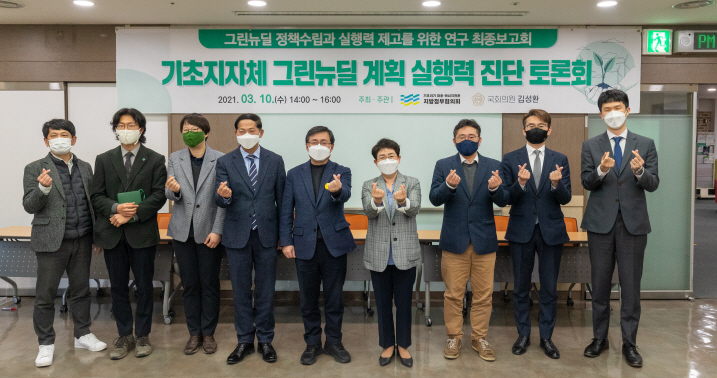
|
|
▲ Along with Democratic Party lawmaker Kim Seong-hwan (5th from the left) and Goyang Mayor Lee Jae-joon (//4th) are taking a commemorative photo with participants at the’Base Local Government Green New Deal Plan Execution Diagnosis Discussion’ held at the Yeouido Eroom Center in Seoul on the 10th. |
[에너지경제신문 이원희 기자] It turns out that there is a long way to go for energy conversion of basic local governments.
The basis for the implementation of carbon neutrality and the Green New Deal, which is being pushed by the central government level, is not well established in the administrative unit of realization of grass-roots democracy.
As a result, it is pointed out that the Moon Jae-in administration’s energy conversion could not yield results in local governments and could only be a relief.
Lee Yoo-jin, director of the Green Transformation Research Institute (special adviser for the Prime Minister’s Green New Deal), held the’Local Government Council on Climate Crisis Response and Energy Conversion’ (Chairman Lee Jae-jun, Mayor of Goyang, Gyeonggi Province) at the Yeouido Eroom Center in Seoul on the 10th. Participated in the’Green New Deal Plan Execution Diagnosis Debate’ and presented on the subject of’Analysis of the Current Status of the Green New Deal Policy and Implementation Barriers of the Baseline System.
According to this analysis conducted by the Green Transformation Research Institute, only four of the 31 basic local governments affiliated with the Local Government Council for Climate Crisis Response and Energy Conversion have a carbon neutral target and the basis for implementing the Green New Deal. In order to promote energy conversion in the region, basic local governments gathered and established a local government council to respond to the climate crisis, but even the basic local governments that belonged to it were still lacking the basis for energy conversion.
Director Lee pointed out, “When the government speaks of the regional balance New Deal, the region is important, but in reality, policies are not all connected from the central government to the metropolitan local government and the basic local government.” This is because basic local governments are difficult to communicate with central governments and large-area local governments, and the budget is highly dependent on public offerings from the central government. He said, “We need to create a channel at all times to connect the government with 17 metropolitan local governments and 226 basic local governments,” he said. “I need it.”
He said, “The central government should establish a policy that encompasses the metropolitan and basic local governments, and the metropolitan local government should also establish a cooperative structure that supports the basic local government with manpower and budget,” he said. At the same time, it added that the local government should focus on establishing and implementing Green New Deal policies appropriate for the region.
The Green Transition Research Institute studied 31 local governments belonging to the local government council for responding to the climate crisis among 226 basic local governments, and classified the Green New Deal policy establishment types into A, B, and C. Dangjin City in Chungnam, Hwaseong City in Gyeonggi Province, Daedeok-gu in Daejeon, and Dobong-gu in Seoul have established a Green New Deal plan, and they thought that the implementation system was specific. Among the remaining 27 local governments, 16 of them have established a Green New Deal plan, but the GHG reduction goal and implementation plan are insufficient. The 11 municipalities are all types and have not yet established a Green New Deal plan. However, it is analyzed that it is planned to be established or that there is a will to establish it.

|
|
▲ Classification of basic local government green new deal policy establishment types. Photo courtesy = Green Transition Research Institute |
Director Lee emphasized, “The base local government is the site where the government’s Green New Deal policy is implemented,” and “It is possible to discover and implement policies in the characteristics of the region, so it is necessary to establish a foundation for the Green New Deal by local governments.” However, he said that there are limitations in the authority and resources of the basic branch system, and there is a lack of basic data for establishing a greenhouse gas reduction plan. Lee also explained that the research was difficult because the names of carbon neutral and Green New Deal were not integrated.
Nevertheless, he introduced that there are remarkable examples of the Green New Deal policy of the local government. Dangjin City intends to complete the construction of the RE100 (Renewable Energy 100%) industrial complex, which covers the power used by companies with renewable energy, by 2023. Hwaseong City plans to promote a citizen fund worth 100 billion won to attract citizens’ participation in the Green New Deal. Dobong-gu is establishing a 2050 carbon neutral plan through the Climate Change Countermeasure Committee composed of public and private sectors. Daedeok-gu is aiming to raise the penetration rate of new and renewable energy to more than 30% by 2030.
Director Lee said, “The Green New Deal of the base local government needs to establish a plan based on the unique situation of various regions. The Green New Deal aims to be carbon neutral in 2050 to respond to the climate crisis, and secure quality jobs and “It should be a’umbrella policy’ that uses the transition to renewable energy and the digital new deal as a means.”
To this end, he stressed that the local government council for climate crisis response should play a role in supporting the basic local governments to establish the Green New Deal in line with rapidly changing government policies.
